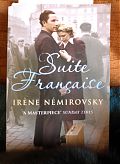
Irène Némirovsky
Suite Française
Suite Française is one of those novels that is difficult to separate from the novelist, and in Irène Némirovsky’s case, the fate of the novelist. It’s a great wonder that we have this book to read. Némirovsky was a Russian Jew who had lived in France since her wealthy family escaped the Russian Revolution. In 1941 she fled Paris after the German occupation, to live in a small town. There she completed the first two parts of Suite Française. But Némirovsky—and a few weeks later, her husband—was deported to Auschwitz, where she was gassed.
The harrowing image of a writer frantically writing in a peaceful forest about the war that would soon claim her, is fantastic. The immediacy of her story—the events occurred not long before she set them to paper—had a way of protecting her from her own bad ending. In Némirovsky’s notebooks—included in my edition—she expresses her wonder at not knowing how Suite Française ends, though she projected it to five parts. Neither did she know about concentration camps or to what lengths the Nazis would go to make life impossible for the Jews. Concentration camps elude the imagination, horrifically surpassing it. One of Suite Française’s strengths is not knowing the end of the war or the end of itself, for I think it would have been quite a different book if Irène Némirovsky would have lived to see liberation. I wish it would have been that different book, though we are lucky to have what we do.
As I wrote, Suite Française is divided into two parts: Storm in June and Dolce. Storm is a musical set of portraits of Parisians fleeing Paris and the German occupation. Dolce is another musical composition that details a small French town during occupation. While I was reading, I was reminded of War and Peace and not only for obvious reasons, but also for a similarity in ambience that Némirovsky’s war-torn people and towns exude—the great movements and the minute details. War sometimes has a comic element when brought down to the level of daily lives, or at least, it wasn’t Némirovsky’s objective to detail mass horrors but to concentrate on individual ways of coping, which can be quite funny.
Both parts of the book include scathing pictures of wealthy French: the Péricands, Gabriel Corte, Charlie Langelet and the Viscountess of Dolce. The exodus from Paris throws the rich deep into the common mêlée with whom they cannot relate. The Catholicism of the matrons is just another rouse that keeps them believing they are above and separate. Poor priest Philippe, the only real pious one, doesn’t stand a chance out on the open roads during such confusing times. When Gabriel Corte and his mistress arrive in the spa-hotel after their adventures leaving Paris, they try their best to forget what had just happened, about the lives they had nearly lost. While the Viscountess comes to see the Germans who have occupied the village as a supreme ruling force that the village had been in need of for some time. More than once this sentiment is expressed:
What separates or unites people is not their language, their laws, their customs, their principles, but the way they hold their knife and fork.
Dolce centers on Lucile and the contradictions of living with the enemy, of closely sharing their joys and fears. They are men after all, like the French men who are held prisoners and occupied German towns during the first World War. Young women have affairs with the Germans because there are no other men around; the villagers take an interest in the Germans’ activities and dress for a party they were not invited to.
Lucile, near the end, thinks:
There’s a world of difference between the young man I’m looking at now and the warrior of tomorrow. It’s a truism that people are complicated, multifaceted, contradictory, surprising, but it takes the advent of war or other momentous events to be able to see it. It is the most fascinating and the most dreadful of spectacles, the most dreadful because it’s so real; you can never pride yourself on truly knowing the sea unless you’ve seen it both calm and in a storm. Only the person who has observed men and women at times like this can be said to know them. And to know themselves.
There is a both calm and storm in Suite Française. The characters weave in and out of each other with sheer mastery of form and it was disappointing, on reaching the end, that I couldn’t read any more. In Irène Némirovsky’s notebooks she details her plans for the following part, Captivity, but no further. A good book to read in tandem with Suite Française is Le Mirador by Némirovsky’s daughter, Élisabeth Gille, an imagined biography of her mother. In Suite Française, life has provided the ending for fiction.
· · · · · · · · · · · · · · · · · · · ·